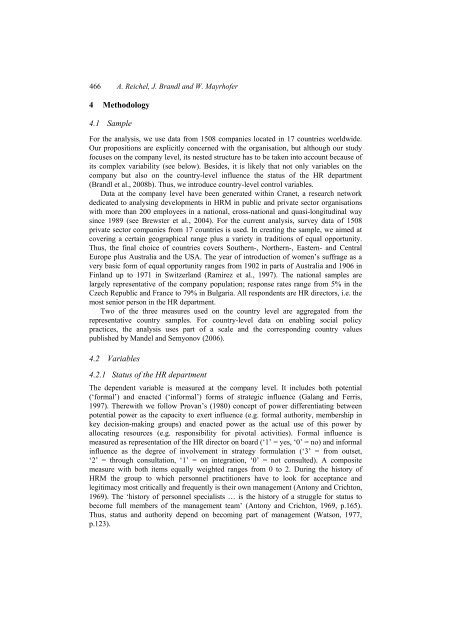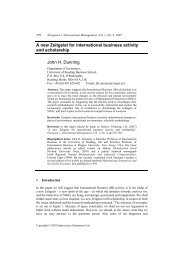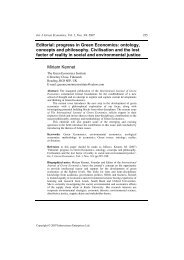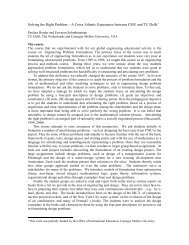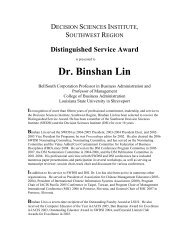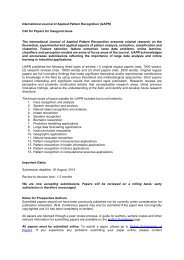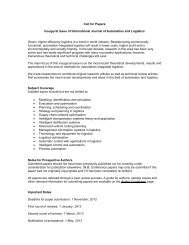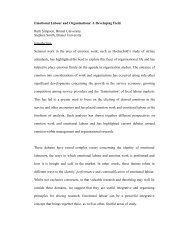View - InderScience
View - InderScience
View - InderScience
Create successful ePaper yourself
Turn your PDF publications into a flip-book with our unique Google optimized e-Paper software.
466 A. Reichel, J. Brandl and W. Mayrhofer<br />
4 Methodology<br />
4.1 Sample<br />
For the analysis, we use data from 1508 companies located in 17 countries worldwide.<br />
Our propositions are explicitly concerned with the organisation, but although our study<br />
focuses on the company level, its nested structure has to be taken into account because of<br />
its complex variability (see below). Besides, it is likely that not only variables on the<br />
company but also on the country-level influence the status of the HR department<br />
(Brandl et al., 2008b). Thus, we introduce country-level control variables.<br />
Data at the company level have been generated within Cranet, a research network<br />
dedicated to analysing developments in HRM in public and private sector organisations<br />
with more than 200 employees in a national, cross-national and quasi-longitudinal way<br />
since 1989 (see Brewster et al., 2004). For the current analysis, survey data of 1508<br />
private sector companies from 17 countries is used. In creating the sample, we aimed at<br />
covering a certain geographical range plus a variety in traditions of equal opportunity.<br />
Thus, the final choice of countries covers Southern-, Northern-, Eastern- and Central<br />
Europe plus Australia and the USA. The year of introduction of women’s suffrage as a<br />
very basic form of equal opportunity ranges from 1902 in parts of Australia and 1906 in<br />
Finland up to 1971 in Switzerland (Ramirez et al., 1997). The national samples are<br />
largely representative of the company population; response rates range from 5% in the<br />
Czech Republic and France to 79% in Bulgaria. All respondents are HR directors, i.e. the<br />
most senior person in the HR department.<br />
Two of the three measures used on the country level are aggregated from the<br />
representative country samples. For country-level data on enabling social policy<br />
practices, the analysis uses part of a scale and the corresponding country values<br />
published by Mandel and Semyonov (2006).<br />
4.2 Variables<br />
4.2.1 Status of the HR department<br />
The dependent variable is measured at the company level. It includes both potential<br />
(‘formal’) and enacted (‘informal’) forms of strategic influence (Galang and Ferris,<br />
1997). Therewith we follow Provan’s (1980) concept of power differentiating between<br />
potential power as the capacity to exert influence (e.g. formal authority, membership in<br />
key decision-making groups) and enacted power as the actual use of this power by<br />
allocating resources (e.g. responsibility for pivotal activities). Formal influence is<br />
measured as representation of the HR director on board (‘1’ = yes, ‘0’ = no) and informal<br />
influence as the degree of involvement in strategy formulation (‘3’ = from outset,<br />
‘2’ = through consultation, ‘1’ = on integration, ‘0’ = not consulted). A composite<br />
measure with both items equally weighted ranges from 0 to 2. During the history of<br />
HRM the group to which personnel practitioners have to look for acceptance and<br />
legitimacy most critically and frequently is their own management (Antony and Crichton,<br />
1969). The ‘history of personnel specialists … is the history of a struggle for status to<br />
become full members of the management team’ (Antony and Crichton, 1969, p.165).<br />
Thus, status and authority depend on becoming part of management (Watson, 1977,<br />
p.123).


